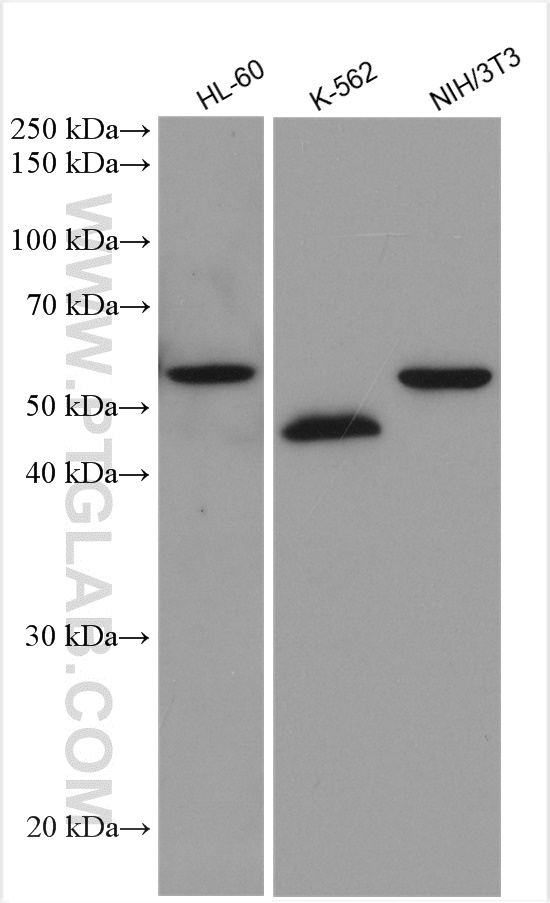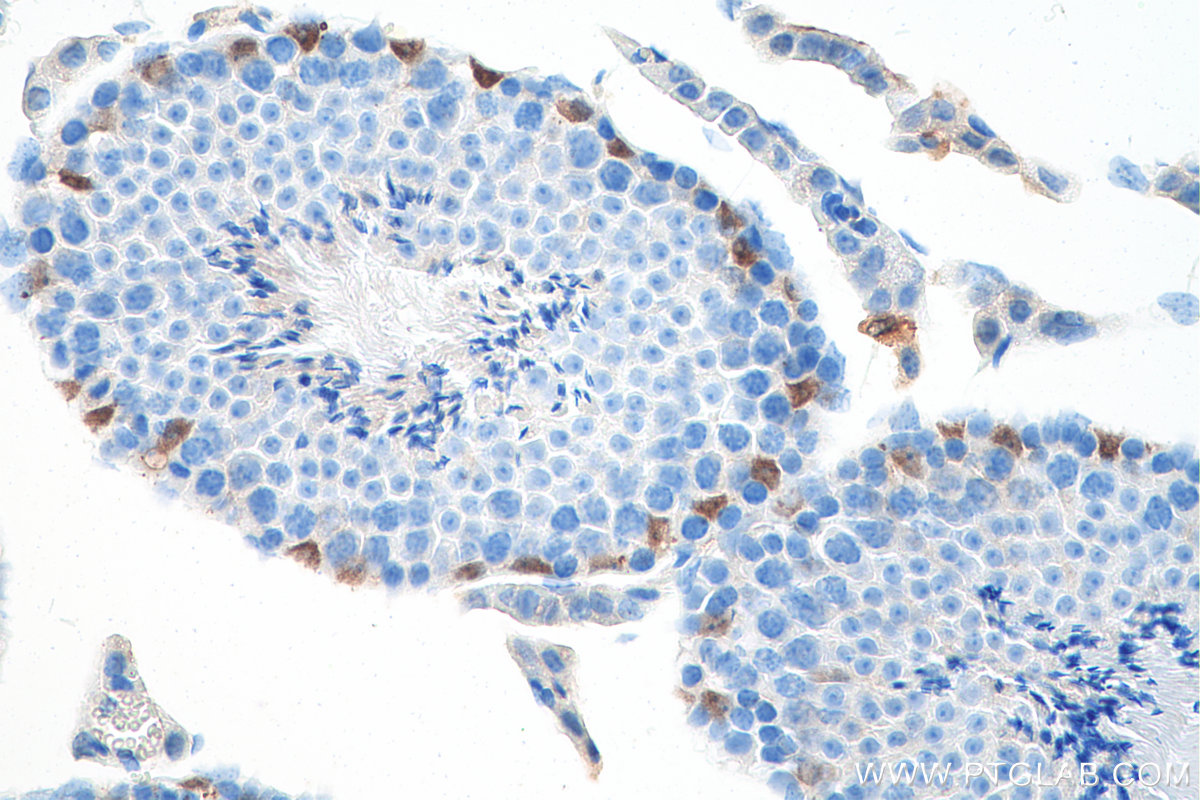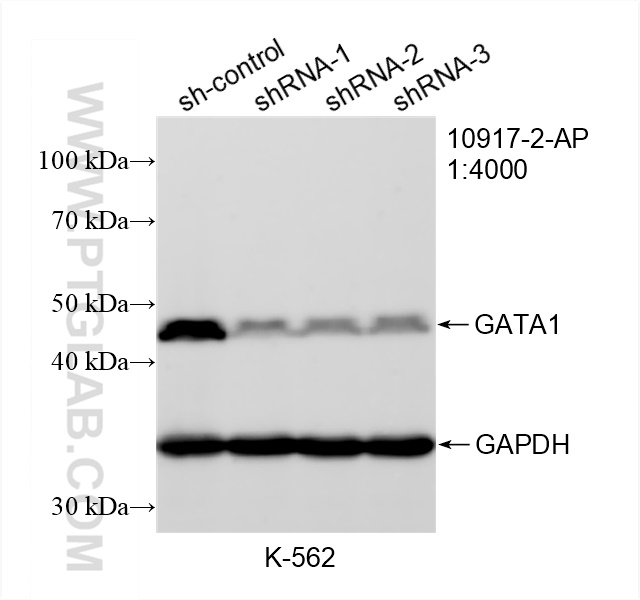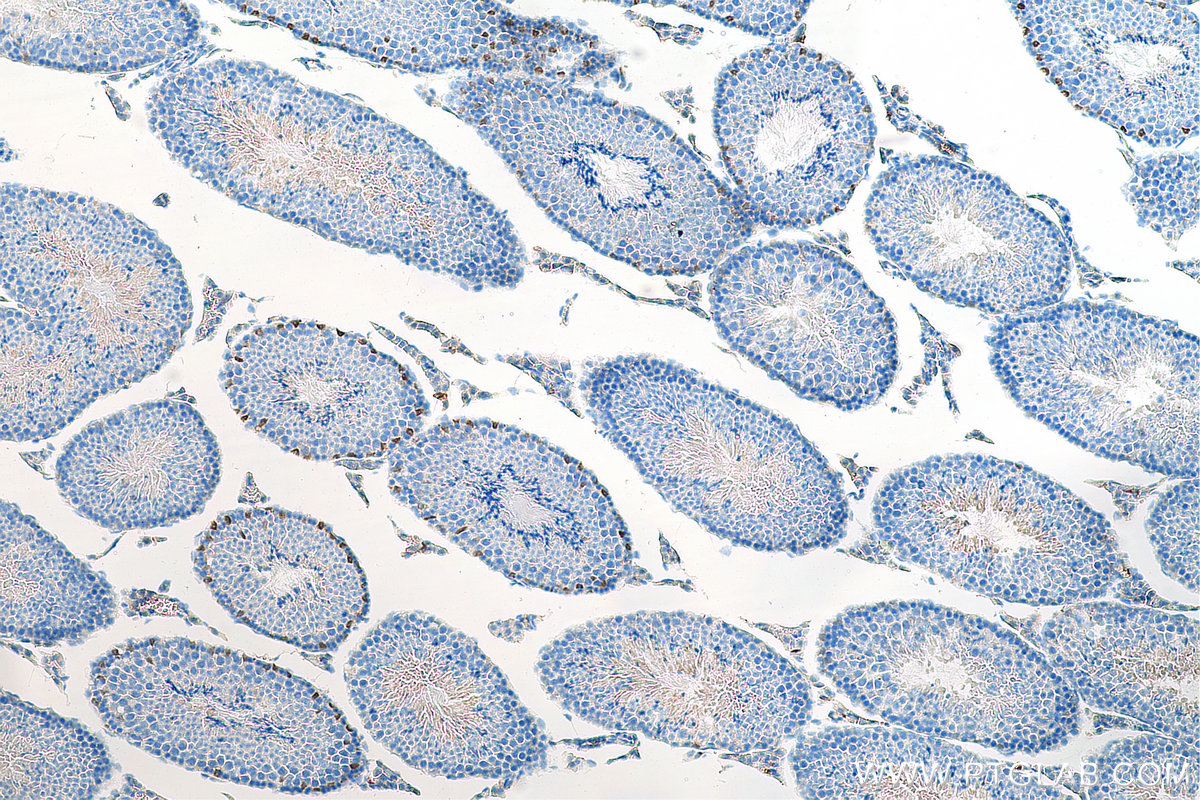验证数据展示
经过测试的应用
| Positive WB detected in | HL-60 cells, Raji cells, K-562 cells, NIH/3T3 cells |
| Positive IP detected in | K-562 cells |
| Positive IHC detected in | mouse testis tissue Note: suggested antigen retrieval with TE buffer pH 9.0; (*) Alternatively, antigen retrieval may be performed with citrate buffer pH 6.0 |
推荐稀释比
| 应用 | 推荐稀释比 |
|---|---|
| Western Blot (WB) | WB : 1:1000-1:6000 |
| Immunoprecipitation (IP) | IP : 0.5-4.0 ug for 1.0-3.0 mg of total protein lysate |
| Immunohistochemistry (IHC) | IHC : 1:50-1:500 |
| It is recommended that this reagent should be titrated in each testing system to obtain optimal results. | |
| Sample-dependent, Check data in validation data gallery. | |
产品信息
10917-2-AP targets GATA1 in WB, IHC, IF, IP, CoIP, ChIP, ELISA applications and shows reactivity with human, mouse samples.
| 经测试应用 | WB, IP, IHC, ELISA Application Description |
| 文献引用应用 | WB, IHC, IF, CoIP, ChIP |
| 经测试反应性 | human, mouse |
| 文献引用反应性 | human, mouse, zebrafish |
| 免疫原 |
CatNo: Ag1350 Product name: Recombinant human GATA1 protein Source: e coli.-derived, PGEX-4T Tag: GST Domain: 1-316 aa of BC009797 Sequence: MEFPGLGSLGTSEPLPQFVDPALVSSTPESGVFFPSGPEGLDAAASSTAPSTATAAAAALAYYRDAEAYRHSPVFQVYPLLNCMEGIPGGSPYAGWAYGKTGLYPASTVCPTREDSPPQAVEDLDGKGSTSFLETLKTERLSPDLLTLGPALPSSLPVPNSAYGGPDFSSTFFSPTGSPLNSAAYSSPKLRGTLPLPPCEARECVNCGATATPLWRRDRTGHYLCNACGLYHKMNGQNRPLIRPKKRLIVSKRAGTQCTNCQTTTTTLWRRNASGDPVCNACGLYYKLHHQHYCGGSAQLMRAQSMASRGGVVSFS 种属同源性预测 |
| 宿主/亚型 | Rabbit / IgG |
| 抗体类别 | Polyclonal |
| 产品类型 | Antibody |
| 全称 | GATA binding protein 1 (globin transcription factor 1) |
| 别名 | ERYF1, Erythroid transcription factor, GATA 1, GATA binding factor 1, GATA1, GF 1, GF1, NF E1 DNA binding protein, NFE1, XLTT |
| 计算分子量 | 43 kDa |
| 观测分子量 | 50-55 kDa, 40-45 kDa |
| GenBank蛋白编号 | BC009797 |
| 基因名称 | GATA1 |
| Gene ID (NCBI) | 2623 |
| RRID | AB_2108279 |
| 偶联类型 | Unconjugated |
| 形式 | Liquid |
| 纯化方式 | Antigen affinity purification |
| UNIPROT ID | P15976 |
| 储存缓冲液 | PBS with 0.02% sodium azide and 50% glycerol, pH 7.3. |
| 储存条件 | Store at -20°C. Stable for one year after shipment. Aliquoting is unnecessary for -20oC storage. |
背景介绍
GATA1 is first identified as a member of the GATA transcription factor family, whose members bind the consensus (WGATAR) binding motif [PMID:22937757]. GATA1, a zinc finger DNA-binding transcription factor, plays a critical role in the normal development of hematopoietic cell lineages. The protein contains an N-terminal region that confers transcriptional activity and a C-terminal domain that mediates binding to DNA and other factors [PMID: 8524811]. GATA-1 is also implicated in regulating the expression of the erythroid and megakaryocytic-specific genes [PMID:22937757]. GATA1 exists two isoform with the molecular weight 50-55 kDa and 40-45 kDa (PMID: 31189107 ).
实验方案
| Product Specific Protocols | |
|---|---|
| IHC protocol for GATA1 antibody 10917-2-AP | Download protocol |
| IP protocol for GATA1 antibody 10917-2-AP | Download protocol |
| WB protocol for GATA1 antibody 10917-2-AP | Download protocol |
| Standard Protocols | |
|---|---|
| Click here to view our Standard Protocols |
发表文章
| Species | Application | Title |
|---|---|---|
Theranostics Differential effect of cancer-associated fibroblast-derived extracellular vesicles on cisplatin resistance in oral squamous cell carcinoma via miR-876-3p
| ||
Oncogene microRNA-23a, -27a and -24 synergistically regulate JAK1/Stat3 cascade and serve as novel therapeutic targets in human acute erythroid leukemia. | ||
iScience Superenhancer-driven circRNA Myst4 involves in pulmonary artery smooth muscle cell ferroptosis in pulmonary hypertension | ||
Front Immunol FLI1 Induces Megakaryopoiesis Gene Expression Through WAS/WIP-Dependent and Independent Mechanisms; Implications for Wiskott-Aldrich Syndrome. | ||
Genes (Basel) Proof of Gene Doping in a Mouse Model with a Human Erythropoietin Gene Transferred Using an Adenoviral Vector. | ||
Oncotarget The transcription factor GATA1 and the histone methyltransferase SET7 interact to promote VEGF-mediated angiogenesis and tumor growth and predict clinical outcome of breast cancer. |







